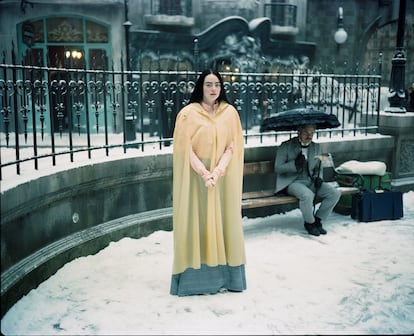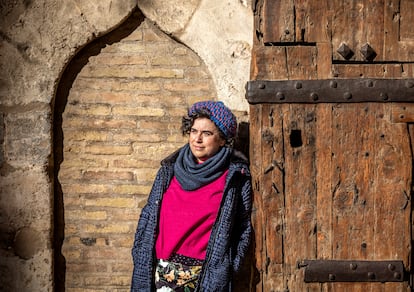Neo-Gothic: why magical horror has invaded trauma narratives
From ‘Poor Things’ to the new ‘True Detective,’ through an explosion in the number of Latina writers, the genre has been updated to reflect on violence and female subjugation


As a Gothic fable that revisits Mary Shelley’s Frankenstein although in women’s liberation mode, Yorgos Lanthimos’ recently released film Poor Things has become one of the season’s phenomena and an awards talisman for its star, Emma Stone. The new True Detective that has provoked so much misogynistic hatred on social media is the new Arctic Gothic, or so has been stipulated by the master of the genre, the writer Joyce Carol Oates (“Alaska in its ‘dark season’ is ideal for hallucinatory visions,” she tweeted about the series that was written and directed by Issa López and stars Jodie Foster). What critics saw in Britney Spears’ memoirs — a publishing phenomenon that sold more than a million copies in its first week in bookstores — was “a descent into hell in the form of a Gothic novel.” Even actress Kristen Stewart now defends that the Twilight saga in which she starred, saying it was nothing more than a gay Gothic narrative about “oppression and wanting what’s going to destroy you.”
The writer Ana Llurba labeled these alternative narratives “black mirrors of fiction,” and they seem to have invaded the stories that reflect on the present. And it seems it hasn’t just happened in series, movies, autobiographies, or reviews of cultural phenomena from the past decade. A new Gothic era is leading contemporary works of trauma fiction.
From Argentina (Mariana Enriquez, Samanta Schweblin, Ana Llurba, Fernanda García Lao) to Mexico (Fernanda Melchor) via Venezuela (Michelle Roche Rodríguez), Ecuador (Mónica Ojeda, Natalia García Freire), Spain (Layla Martínez, Purificació Mascarell), and finally reaching the United States (Carmen María Machado, Sarah Manguso), a legion of writers has taken a step beyond the traditional American Southern Gothic and the Latin American Gothic of the last century to explore human fragility, each in their own way, through fear, alchemy, and the supernatural. The majority uses the female body as a landscape for the violence and evils of the present. They all draw on the terror and intimacy of our nightmares to seek answers to the cruelty that surrounds us.

To each territory, a different wound
“When we talk about violence, we are always talking about fear and desire. The Gothic has explored these emotions and has expanded. It has mutated, until it broke the molds of the horror genre,” explains Mónica Ojeda, the writer who, after being a finalist for the National Book Award for Jawbone (2022), is leading the new Andean Gothic movement. She will publish the long-awaited Chamanes eléctricos en la fiesta del sol (available only in Spanish) in February.
As a defender of this turn as “a work of emotional potholing,” the Ecuadorian asserts that what distinguishes this period is treating the landscape as something alive and not as a simple stage. “Each society has particular fears that respond to its own historical experiences. Gothic studies the history of a certain geography, its mythologies, its oral history, its way of narrating itself, its traumas, and its wounds. In Ecuador, for example, traditional horror narratives have been linked to colonialism, racism, and exclusion in general,” she argues about a genre that no longer seeks to provoke fear in the reader, but rather “bring them closer to the sublime.”

Her next novel, set in a hallucinated retro-futuristic landscape where a young woman attends a music festival in Guayaquil that brings together thousands of people for several days, would not be what it is without the political awakening of her generation. “There has been a change in reception. Many things have happened: different kinds of feminism, the recognition that we live in neocolonial societies with normalized structures of violence, the creation of the term ‘femicide.’ Before, people also wrote about violence and the fear it instills, but we ask ourselves different questions than writers did in the 1970s. The Tunnel by Sábato has nothing to do with Liliana’s Invincible Summer by Cristina Rivera Garza. They are different approaches when it comes to narrating violence,” she argues.
Rephrase myths
“The Gothic has always revolved around the female experience, living under male dominance and negotiating both love and fear of men. As in the past, women must live with their oppressors and, in many cases, they must love and trust them to be happy,” the film director and now also a writer Anna Biller points out. After her film The Love Witch became a cult film, she has just debuted with the Gothic novel Bluebeard’s Castle, a revision of the erotic Gothic tale in which its protagonist, a successful writer, moves into a castle with her new lover and there she will discover how evil he is. The interesting thing about this new wave of which she is a part, Biller explains, is adding complexity to the supposed victims of this violence: “In these new narratives, women are seen as complex poor with enormous appetites. Inside, she is messy, rude, crazy and rebellious, although she is generally conventionally attractive and appears harmless on the outside,” she points out.
Something similar happens in Mireia, the novel by Purificació Mascarell, originally published in Valencian. The winner of the Lletraferit book festival in 2022 translated the book into Spanish herself at the Dos Bigotes publishing house. There, the Gothic archetypes are updated to revisit the myth of Lilith and the prejudices about the femme fatale.

Mireia recovers the stories of the experiments at the Salpêtrière hospital in which thousands of marginal women were forcibly locked up under the diagnosis of female hysteria and criticizes the intellectual vampirism that painters exercised on their muses, such as Elizabeth Siddal. It is a vindication for those women who challenged male control and who were subjected to violence for doing so.
Via email, Mascarell says that the Gothic is reinvented in each generation of authors “because it contains the power of those stories that mothers told their daughters to warn them of dangers and horrors that stalk us.”
Towards a Gothic feminism
With anguish and discomfort as the social heartbeat of our time, it makes sense that these authors and themes have permeated autofiction and essays that analyze the present. Mar García Puig, influenced by The Yellow Wallpaper by Charlotte Perkins, vindicated all the Victorian writers and their stories of psychiatric disorders in The History of Vertebrates to contextualize female alienation as a reaction to the repressive control of women’s bodies.

In the recent essay Traumacore: Crónicas de una disociación feminista (in English, Traumacore: Chronicles of a feminist dissociation), researcher Núria Gómez Gabriel relies on the authors of the new Latin American Gothic and the theories of Sarah Ahmed and Julia Kristeva to claim a “Gothic, deranged, and melancholic feminism” in this era of uncertainty and social disorientation. If women today spend their lives exhausted and dissociated, she argues, it is as a reaction to the idea of an optimistic feminism, to the myth of self-made women with which an entire generation of young people who wrongly believed in the culture of effort.
“The Gothic perspective allows us to think about how we relate to the deformations and alterations of our bodies and our vital signs in a feminist key to exorcise systemic guilt,” says the cultural communicator. She has grown close to Gothic authors thanks to the workshops facilitated by writer Ana Llurba. Reading it, it is not surprising that all these series, films, and Gothic horror fictions full of violated and alienated women have exploded in parallel. Magic mirrors that reflect of our desires and fears are not so deformed after all.
Sign up for our weekly newsletter to get more English-language news coverage from EL PAÍS USA Edition
Tu suscripción se está usando en otro dispositivo
¿Quieres añadir otro usuario a tu suscripción?
Si continúas leyendo en este dispositivo, no se podrá leer en el otro.
FlechaTu suscripción se está usando en otro dispositivo y solo puedes acceder a EL PAÍS desde un dispositivo a la vez.
Si quieres compartir tu cuenta, cambia tu suscripción a la modalidad Premium, así podrás añadir otro usuario. Cada uno accederá con su propia cuenta de email, lo que os permitirá personalizar vuestra experiencia en EL PAÍS.
¿Tienes una suscripción de empresa? Accede aquí para contratar más cuentas.
En el caso de no saber quién está usando tu cuenta, te recomendamos cambiar tu contraseña aquí.
Si decides continuar compartiendo tu cuenta, este mensaje se mostrará en tu dispositivo y en el de la otra persona que está usando tu cuenta de forma indefinida, afectando a tu experiencia de lectura. Puedes consultar aquí los términos y condiciones de la suscripción digital.
More information
Últimas noticias
Most viewed
- David King, chemist: ‘There are scientists studying how to cool the planet; nobody should stop these experiments from happening’
- Reinhard Genzel, Nobel laureate in physics: ‘One-minute videos will never give you the truth’
- Mexico completes its trade shift with the entry into force of tariffs on China and countries without trade agreements
- Oona Chaplin: ‘I told James Cameron that I was living in a treehouse and starting a permaculture project with a friend’
- Sinaloa Cartel war is taking its toll on Los Chapitos










































